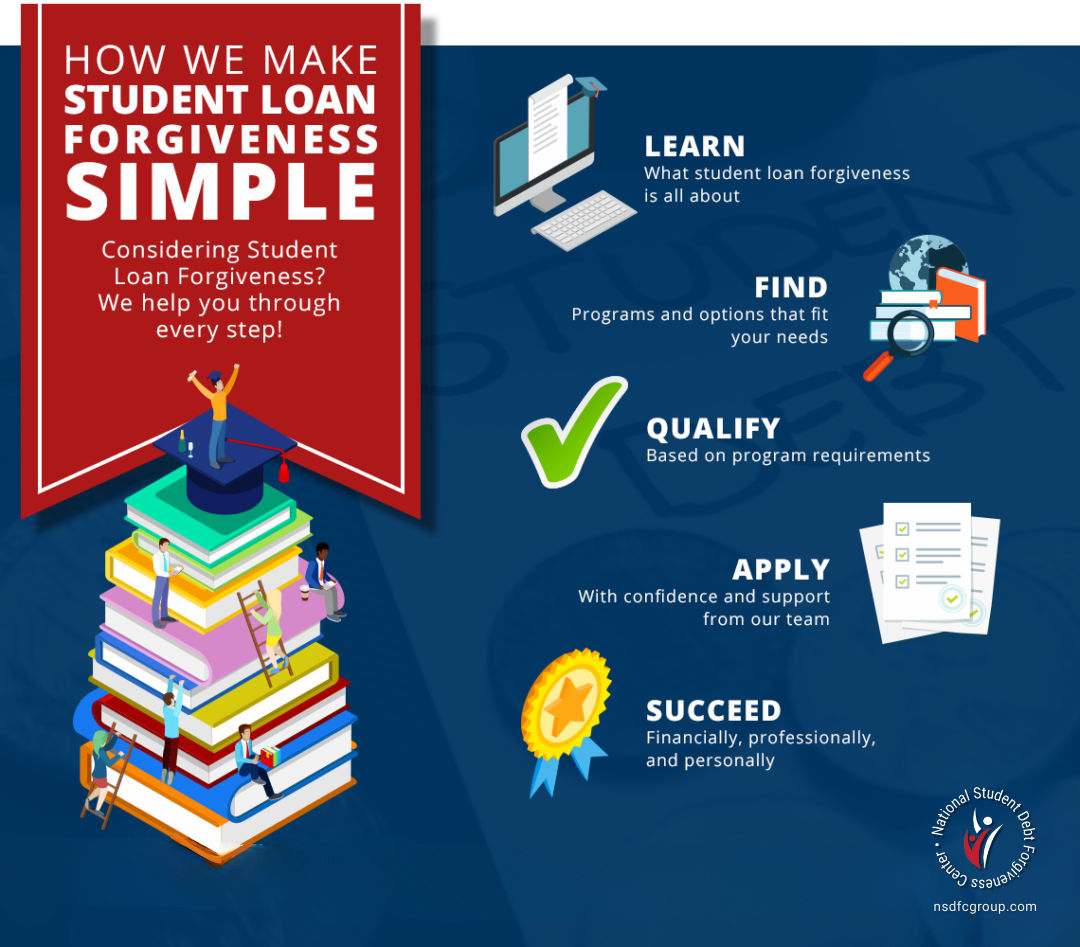Student Loan Repayment Program Consultants
Teacher Loan Forgiveness (TLF)
Eligible teachers may qualify for up to $17,500 in federal student loan forgiveness.
As a teacher, we don’t have to tell you that the pay is rarely equal to the work and is likely not even enough to pay off the student loans you had to take in order to become a teacher in the first place! Sadly, this leads many good, qualified teachers to leave the profession and look for more lucrative work. In an effort to keep good teachers in the classroom the federal government and even some state governments offer Teacher Loan Forgiveness to those who qualify.
What is Teacher Loan Forgiveness (TLF)?
In a nutshell, the Teacher Loan Forgiveness (TLF) Program allows certain teachers to earn forgiveness of their federal student loans in amounts of up to $5,000 or $17,500 (depending on qualifications) after five complete and consecutive years of teaching in a qualified low-income school. If you qualify for TLF, you could earn substantial, if not full loan forgiveness, just by doing what you’re already doing. Talk with our loan forgiveness specialists to see if you qualify for this program!

FORGIVENESS VS. DISCHARGE
It’s important to understand the distinction between the two ways in which a person may no longer be responsible for repayment of their student loans.
Discharge
Loan discharge is the removal of a borrower’s obligation to repay some or all of a loan under specific circumstances, i.e., death, total and permanent disability, school closing before a degree is completed, borrower defense to repayment, bankruptcy, fraud, false certification, unpaid refund, identity theft, and disasters. These circumstances may entitle you to apply for a loan discharge, but only in certain situations.
Forgiveness
By contrast, student loan forgiveness is offered to encourage certain types of employment, i.e., jobs that may not offer high pay, or that involve service in low-income areas. A loan may be fully or partially forgiven after a certain number of years of qualifying employment. Along with Borrower Defense to Repayment, Perkins Loan Forgiveness, and Public Service Loan Forgiveness, Teacher Loan Forgiveness falls into this category.
Note: Whether by discharge or by forgiveness, if you are freed from the obligation of repaying all or a portion of the remainder of your loan, the amount of money you have discharged or forgiven may be considered income and subject to federal tax.
The loan forgiveness specialists at the National Student Debt Forgiveness Center can help you determine which option could work for you, help you with the application process, and provide advice throughout the process.
Eligibility requirements for TLF
- You must not have had an outstanding balance on Direct Loans or Federal Family Education Loan (FFEL) Program loans as of Oct. 1, 1998, or on the date that you obtained a Direct Loan or FFEL Program loan after Oct. 1, 1998.
- You must have been employed as a full-time, highly qualified teacher for five complete and consecutive academic years, and at least one of those years must have been after the 1997–98 academic year.
- You must have been employed at an elementary school, secondary school, or educational service agency that serves low-income students (a “low-income school or educational service agency”).
- The loan(s) for which you are seeking forgiveness must have been made before the end of your five academic years of qualifying teaching service.
What if I taught for less than a complete academic year?
Good news! If you were unable to complete a full academic year of teaching, that year may still be counted toward the required five complete and consecutive academic years if:
- you completed at least one half of the academic year; and
- your employer considers you to have fulfilled your contract requirements for the academic year for the purposes of salary increases, tenure, and retirement; and
- you were unable to complete the academic year due to one of the following reasons:
- You returned to postsecondary education, on at least a half-time basis, in an area of study directly related to the performance of the teaching service described above; or
- You had a condition covered under FMLA; or
- You were called or ordered to active duty status for more than 30 days as a member of a reserve component of the U.S. armed forces.
How much can be forgiven?
The amount of your loans that can be forgiven varies depending on your specific circumstances, but, as a teacher, you may be eligible for forgiveness of $5,000 or $17,500 of your qualified student loans. You may also qualify for Public Service Loan Forgiveness, a separate program that offers forgiveness of 100% of your remaining loan after ten years of full-time qualifying employment. For now, let’s focus on TLF and the difference between eligibility for $5,000 and eligibility for $17,500 in loan forgiveness.
You may receive up to $17,500 in loan forgiveness if you were:
- a highly qualified full-time mathematics or science teacher who taught students at the secondary school level; or
- a highly qualified special education teacher (at either the elementary or secondary level) whose primary responsibility was to provide special education to children with disabilities, and you taught children with disabilities that corresponded to your area of special education training and demonstrated knowledge and teaching skills in the content areas of the curriculum that you taught.
You may receive up to $5,00 in loan forgiveness if you were:
- a highly qualified full-time elementary or secondary education teacher who didn’t teach mathematics, science, or special education.
Defining Low-income School or Educational Service Agency
Every year, the U.S. Department of Education publishes its Teacher Cancellation Low Income (TCLI) Directory. To see if your school is on the list, simply visit the TCLI Directory at https://studentaid.gov/tcli/. If it is, you’re eligible; if not, you are ineligible.
If your school or educational service agency is on the list, be sure to enter its name exactly as it appears in the directory; otherwise, your application will be rejected. Think of it like endorsing a check: You endorse a check exactly the way your name appears in the “Pay to the order of” section, so the bank knows you are the person for whom the check was intended. The same is true with entering the name of your school in the application. If you don’t enter the school’s name exactly as it appears in the TCLI Directory, there’s no way to ensure that you are teaching in a school designated for this purpose.
All elementary and secondary schools operated by the Bureau of Indian Education (BIE) or operated on Indian reservations by Indian tribal groups under contract with the BIE qualify as schools serving low-income students. This remains true whether or not they were listed in the TCLI Directory.
What if your school was on the list during one of your five consecutive years of service, but not during the other four?
Don’t worry. If your school or educational service agency is included in the TCLI Directory for at least one year of your teaching service, but is not included during subsequent years, your subsequent years of teaching at the school or educational service agency will still be counted toward the required five complete and consecutive academic years of teaching.
Teaching service performed at an educational service agency may be counted toward the required five years of teaching only if the consecutive five-year period includes qualifying service at an eligible educational service agency performed after the 2007–08 academic year.
As you read these qualifications for Teacher Loan Forgiveness, two terms keep popping up: “qualified low-income school” and “highly qualified teacher.” Since these two terms are key to qualifying for loan forgiveness under this program, let’s have a closer look at what they mean.
What constitutes a highly qualified teacher?
Status as a highly qualified teacher has a set of basic requirements for all teachers, as well as specific requirements depending upon whether you are an elementary or secondary school teacher, or a new teacher.
Basic requirements for all teachers:
To be considered highly qualified, all teachers must have:
- attained at least a bachelor’s degree;
- received full state certification as a teacher; and
- not had certification or licensure requirements waived on an emergency, temporary, or provisional basis.
You’re considered to have received full state certification even if you received your certification through alternative routes to certification or by passing the state teacher licensing examination.
If you’re a teacher at a public charter school, you are considered to have received full state certification as a teacher if you meet the requirements set forth in the state’s public charter school law.
Requirements for new elementary school teachers:
In addition to the requirements for all teachers, new elementary school teachers must pass a rigorous text to demonstrate subject knowledge and teaching skills in reading, writing, math, and other basic areas of the elementary school curriculum. The rigorous state test may be a state-required certification or licensing test or tests in reading, writing, mathematics, and other areas of the basic elementary school curriculum.
Requirements for new middle school and secondary school teachers:
In addition to the requirements for all teachers, new middle school and secondary school teachers must also demonstrate a high level of competency in each of the academic subjects in which they teach. There are two ways to do this:
- pass a rigorous state academic subject test in each of the academic subjects in which they teach, or
- successfully complete an academic major, a graduate degree, course work equivalent to an undergraduate academic major, or an advanced certification or credential in each of the academic subjects in which they teach
The rigorous state test may be a state-required certification or licensing test or tests in each of the academic subjects in which they teach.
Additional requirements teachers who are not new to the profession
In addition to the requirements for all teachers, to be highly qualified as an elementary, middle, or secondary school teacher who is not new to the profession, teachers must also:
- meet the applicable requirements for an elementary, middle, or secondary school teacher who is new to the profession, or
- demonstrate competence in all the academic subjects in which you teach based on a high, objective, uniform state standard of evaluation.
You’re considered to have received full state certification even if you received your certification through alternative routes to certification or by passing the state teacher licensing examination.
If you’re a teacher at a public charter school, you are considered to have received full state certification as a teacher if you meet the requirements set forth in the state’s public charter school law.
Whew! That’s a lot of information! Now that you know what constitutes a qualified low-income school and understand what is required to be considered a highly-qualified teacher, it’s simple: If you are a highly-qualified teacher who teaches in a qualified low-income school for five consecutive years, you are eligible for some amount of Teacher Loan Forgiveness.
But you must APPLY!
For help in determining your eligibility and your specific level of potential loan forgiveness, contact us today!
Wondering if you're eligible?
Interested in setting up a no-obligation consultation?
More Info
Address: 330 Motor Parkwy, Suite 308
Hauppauge, New York 11788
Phone: 888-384-0877
Email: inquiries@nsdfcgroup.com

Select Page